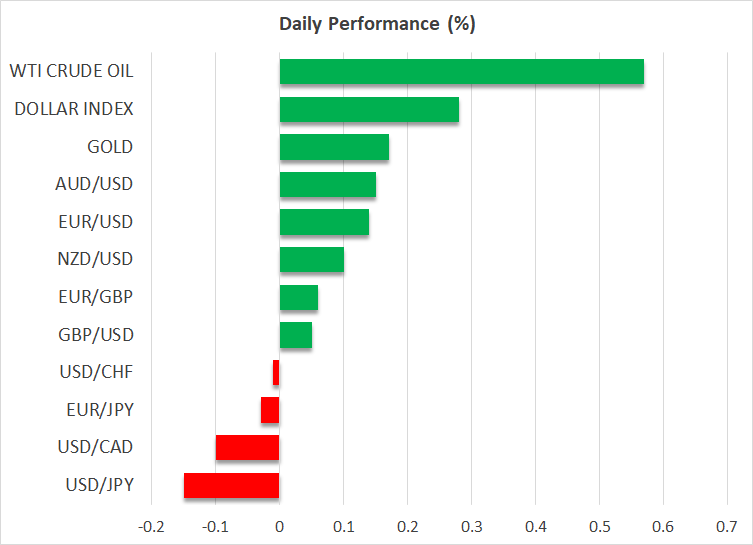- Intervention threat spurs mild rebound in yen after top currency official’s warning
- Yuan also rebounds, triggering broader retreat in US dollar
- Stock market rally cools amid quieter week before Easter break, core PCE eyed

Yen firmer after fresh verbal intervention
The Japanese yen edged higher on Monday, starting the holiday-shortened week on a steadier note, following a 3.5% slide on the back of the Bank of Japan’s dovish rate hike last week. Whilst the BoJ’s historic exit from negative rates had been well telegraphed, investors were disappointed by the apparent lack of clues about further rate hikes and the yen plummeted in the aftermath, even as other central banks gave their strongest indication yet that rate cuts are coming.
But predictably, as the selloff dragged the currency closer to the 152 per dollar floor, Japanese officials started to sound the alarm bells. After Finance Minister Suzuki’s somewhat restrained comments on Friday, there was stronger language today from his deputy, Masato Kanda, who oversees foreign exchange moves.
Calling the current weakening as “not in line with fundamentals”, Kanda warned that the government is not ruling out any options and “will take appropriate action against excessive fluctuations”.
The yen has since firmed to around 151.30 per dollar but is far from being out of the woods when it comes to being susceptible to further speculative attacks. As things stand right now, the yen’s best chance of a meaningful rebound is if the BoJ’s Summary of Opinions of the latest meeting reveals policymakers are open to further tightening when it’s published early on Thursday.
Yuan also finds its feet
Another currency enjoying some reprieve today is the Chinese yuan. State-owned banks have reportedly stepped up their selling of US dollars in a bid to bolster the yuan after Friday’s lower midpoint generated some angst in the markets. Authorities are likely mindful of not letting the yuan depreciate too quickly as investors tend to interpret that as a sign of declining confidence in the economy.
The bounce back in both the yen and yuan is a setback for dollar bulls, however, with the US currency trading flat or slightly lower against all its major peers on Monday.
Dollar bulls pause for breath, Powell and core PCE eyed
It’s hard to say if the dollar’s latest rebound has run its course or not, but it’s possible this is just a temporary pause. Atlanta Fed chief, Raphael Bostic, cast doubt on Friday about the Fed’s latest dot plot that maintained policymakers’ three-rate cut projection for 2024. Bostic, who is a voting FOMC member this year, told reports he anticipates only one rate cut in 2024, as he’s less sure about inflation falling towards 2% than he was in December.
This contrasts with Chair Powell’s more optimistic view on inflation in his post-meeting press appearance last Wednesday that sparked a rally in bonds and equities. Powell is due to speak again on Friday when the latest PCE inflation readings will also be released. Although it’s unlikely that Powell will deviate much from his recent remarks, there’s a danger of a pullback should he highlight the upside risks to inflation, especially if core PCE comes in hot again.
Stocks could consolidate ahead of Easter
The other risk is that any reaction could be exaggerated amid low liquidity around the Easter holiday weekend, as US markets will be closed on Friday and won’t reopen until Monday when most other major markets will remain shut.
The S&P 500 ended its three-day winning streak of record highs on Friday by closing slightly lower, with US futures trading in the red today.
Tepid rebound for euro and pound, oil up too
In the broader FX sphere, the euro and pound were marginally higher following last week’s steep falls when the SNB’s surprise rate cut helped underscore the BoE’s and ECB’s dovish tilt at their respective meetings.
The Australian dollar managed a somewhat more solid rebound on Monday, aided by the stronger yuan.
Oil prices also headed higher, finding support in the flareup of fighting between Ukraine and Russia in recent days, as well as from the lack of fresh progress in ceasefire talks between Israel and Hamas.

